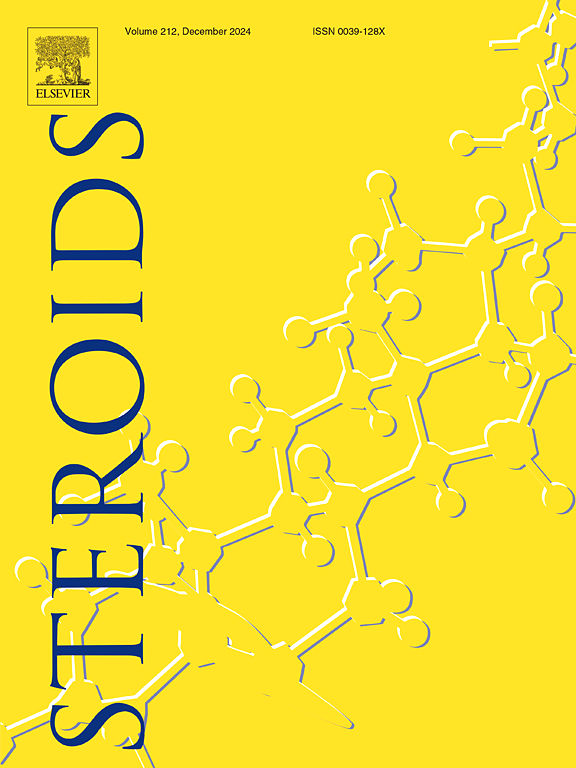Exploring the urate lowering properties of Erigeron annuus Lin. and phytosterol contributions: In vitro assays and in silico approaches
IF 2.1
4区 医学
Q4 BIOCHEMISTRY & MOLECULAR BIOLOGY
引用次数: 0
Abstract
Background
Due to the severe hypersensitivity risks associated with some xanthine oxidase (XO) inhibitors, there is a pressing need to develop novel agents with improved safety and effective ADME profiles. This study evaluates the antihyperuricemic and antioxidant potential of Erigeron annuus Lin. (E. annuus) using in vitro and in silico models.
Objective
To assess the in vitro XO inhibitory and antioxidant activities of the hydroalcoholic crude extract, fractions, and isolated compounds from the aerial parts of E. annuus Lin.
Methods
A hydroalcoholic extract was prepared using a Soxhlet apparatus. Column chromatography and spectroscopic techniques were employed to isolate and identify two phytosterols: RR1 (β-sitosterol) and RR2 (stigmasterol). A further pharmacophore-based hypothesis was developed using DE Shaw Desmond software; an in-silico profile was also evaluated using LeadIT software and Swiss ADME, respectively. XO inhibitory activity was measured using a Biotek multi-mode plate reader, and antioxidant activity was assessed via the DPPH and FRAP assay. Additionally, potent compound RR2 was also evaluated for its cytotoxicity against HepG2 cell line.
Results
All tested extracts and fractions inhibited XO activity, with IC50 values ranging from 0.086 µg/mL to 36.71 µg/mL. Allopurinol, used as a positive control, had an IC50 of 0.027 µg/mL. The hexane fraction of E. annuus exhibited the most vigorous XO inhibitory activity (IC50 = 0.086 µg/mL). RR2 (stigmasterol) showed notable inhibition from this fraction with an IC50 of 0.331 µg/mL. Antioxidant assays and cytoxicity study also supported the bioactivity of these fractions.
Conclusion
The hexane fraction of E. annuus demonstrated potent XO inhibitory activity, highlighting its potential as a source for developing herbal treatments for hyperuricemia and gout. The study validates traditional use and supports the pharmacophore hypothesis, suggesting that structural optimization of the sterol nucleus could enhance therapeutic efficacy.
探讨了灯盏花的降尿酸性能。和植物甾醇的贡献:体外分析和计算机方法
由于一些黄嘌呤氧化酶(XO)抑制剂存在严重的超敏风险,因此迫切需要开发具有更高安全性和有效ADME特性的新型药物。本研究评价了春花的抗高尿酸和抗氧化活性。(E. annuus)在体外和计算机模型中的应用。目的研究黄连地上部水醇粗提物、分离部位及分离化合物的体外XO抑制和抗氧化活性。方法采用索氏装置制备水乙醇提取物。采用柱层析和光谱技术分离鉴定了两种植物甾醇:RR1 (β-谷甾醇)和RR2(豆甾醇)。使用DE Shaw Desmond软件进一步提出了基于药效团的假设;还分别使用LeadIT软件和Swiss ADME对硅片进行了评估。使用Biotek多模式平板阅读器测量XO抑制活性,通过DPPH和FRAP测定抗氧化活性。此外,我们还评估了强效化合物RR2对HepG2细胞株的细胞毒性。结果各萃取部位对XO活性均有抑制作用,IC50值在0.086 ~ 36.71µg/mL之间。别嘌呤醇作为阳性对照,IC50为0.027µg/mL。正己烷部位对XO的抑制作用最强(IC50 = 0.086µg/mL)。RR2 (stigmastrol)对该部位有明显的抑制作用,IC50为0.331µg/mL。抗氧化试验和细胞毒性研究也证实了这些组分的生物活性。结论荆芥正己烷部分具有较强的XO抑制活性,为开发高尿酸血症和痛风的草药治疗提供了重要的研究价值。该研究验证了传统用法,支持药效团假说,提示甾醇核结构优化可提高治疗效果。
本文章由计算机程序翻译,如有差异,请以英文原文为准。
求助全文
约1分钟内获得全文
求助全文
来源期刊

Steroids
医学-内分泌学与代谢
CiteScore
5.10
自引率
3.70%
发文量
120
审稿时长
73 days
期刊介绍:
STEROIDS is an international research journal devoted to studies on all chemical and biological aspects of steroidal moieties. The journal focuses on both experimental and theoretical studies on the biology, chemistry, biosynthesis, metabolism, molecular biology, physiology and pharmacology of steroids and other molecules that target or regulate steroid receptors. Manuscripts presenting clinical research related to steroids, steroid drug development, comparative endocrinology of steroid hormones, investigations on the mechanism of steroid action and steroid chemistry are all appropriate for submission for peer review. STEROIDS publishes both original research and timely reviews. For details concerning the preparation of manuscripts see Instructions to Authors, which is published in each issue of the journal.
 求助内容:
求助内容: 应助结果提醒方式:
应助结果提醒方式:


